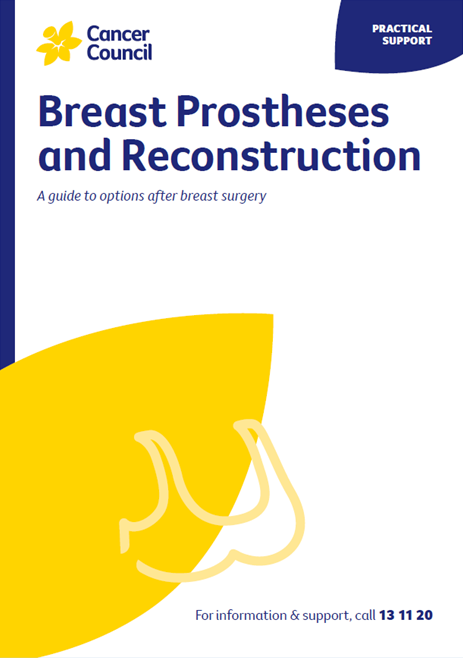- Home
- About Cancer
- Managing side effects
- Breast prostheses and reconstruction
- Breast prostheses
- Material used in prostheses
Material used in prostheses
Temporary soft prostheses
These tend to be made with foam, fibre fill or fleece. In the first couple of weeks or months after surgery, you will be given a temporary prosthesis to wear while you heal. Another option is to use the temporary soft prosthesis with a knitted cotton cover called a knitted knocker, which often includes the shape of a nipple.
To order a knitted knocker, visit Knitted Knockers Australia. You may find some temporary prostheses are more comfortable than others. Your breast care nurse can organise a temporary soft prosthesis for you (see My Care Kit). Once the area has healed, you can continue to wear the soft prosthesis at night-time.
Permanent breast prostheses
These are usually used long term and are mostly made from medical grade silicone gel. Silicone is a non-toxic manufactured substance that is heat-resistant and rubbery. If a prosthesis tears or punctures, the silicone can’t be absorbed by the skin.
The silicone is moulded into the shape of a breast or part of a breast. The front surface feels soft and smooth. The back surface, which rests against the body, varies depending on whether the prosthesis is designed to go into a bra pocket or attach directly to your skin. It can be firm and smooth; flat or hollow; have ridges that are soft and flexible; have a thin film that clings gently to the skin; or be made of fabric. A new type of prosthesis has an inflatable back that you can adjust for comfort. See Different breast prostheses and their features for more details.
Most permanent prostheses are weighted to feel similar to your remaining breast (if only one breast has been removed), but lightweight styles are also available. Some prostheses include a nipple outline, or you can buy a nipple that attaches to the prosthesis.
Breast forms are very well designed these days. Anyone pressing up against you would not know the difference – not like the days when they were filled with bird seed or rice.
Jan
→ READ MORE: Types of prostheses
More resources
Dr Jane O’Brien, Specialist Oncoplastic Breast Cancer Surgeon, St Vincent’s Private Hospital, VIC; Clare Bradshaw, Clinical Nurse Consultant, Breast Assessment Unit, Fiona Stanley Hospital, WA; Rene Hahn, Consumer; Sinead Hanley, Consumer; Dr Marc Langbart, Specialist Plastic and Reconstructive Surgeon, Randwick Plastic Surgery, NSW; Melanie Law, Consumer; Sally Levy, Consumer; Annmaree Mitchell, Consumer; Ashleigh Mondolo, Breast Cancer Nurse Clinical Consultant, Mater Private Hospital Brisbane, QLD; Rochelle Osgood, Clinical Nurse Consultant – McGrath Breast Care Nurse, Sunshine Coast University Hospital, QLD: Dr Kallyani Ponniah, Head of Department, Breast Centre, Sir Charles Gairdner Hospital, WA; Meg Rynderman OAM, Consumer; Sarah Stewart, Breast Care Nurse, The Royal Women’s Hospital, VIC; Erin Tidball, 13 11 20 Consultant, Cancer Council NSW; Jane Turner, Senior Exercise Physiologist, Sydney Cancer Survivorship Centre, Concord Cancer Centre, NSW.
View the Cancer Council NSW editorial policy.
View all publications or call 13 11 20 for free printed copies.

